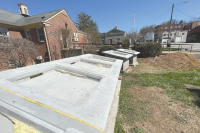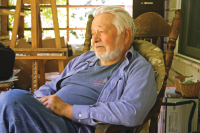Plott-tober Fest to draw national competitors
Plott hound enthusiasts and their pups from across the United States will assemble to compete in bear bay and coon treeing contests, as well as a sanctioned UKC bench show as part of Plott-tober Fest in Canton from Oct. 5-8.
Plott hounds hold unique place in WNC history
I had my first encounter with a prize-winning Plott hound several years ago when I was hosting a Liars Bench program at Western Carolina University. I had asked David Brewin to bring Nannie, his Plott hound, to the program.
As I remember it now, Nannie was not on a leash, but it seemed unnecessary. She came and sat by David and surveyed the people in the audience, her dark brendle coat shimmering under the lights. No stranger to crowds, she was calm, even composed and she seemed to briefly study each individual on the crowded stage.
Public art set for Hazelwood
The Town of Waynesville has selected an artist and an art piece for its latest public art installation.
Plans under way for Plott hound art piece in Hazelwood
 Hazelwood will soon be home to a sculpture of a Plott hound, the fabled bear-hunting breed steeped in local lore and history.
Hazelwood will soon be home to a sculpture of a Plott hound, the fabled bear-hunting breed steeped in local lore and history.
Everything but the kitchen sink: A conversation with Frank Solivan
 He stood out like a sore thumb.
He stood out like a sore thumb.
Standing on the red carpet at the International Bluegrass Music Association awards in Raleigh last fall, I found myself in the midst of the biggest names in the genre. To the right were The Gibson Brothers, Sam Bush and Claire Lynch, to the left Bela Fleck, Rhonda Vincent and The Del McCoury Band — a who’s who of string music.
Festival puts spotlight on Haywood-bred Plott hound
 This year’s PlottFest will give hound enthusiasts from the region, across the country and around the globe a chance to celebrate their favorite breed of dog in its ancestral home.
This year’s PlottFest will give hound enthusiasts from the region, across the country and around the globe a chance to celebrate their favorite breed of dog in its ancestral home.
Although the fledgling festival, only in its second year, will showcase a wide variety of mountain music, fishing and other events, this year, organizers have decided to place an emphasis on the pride of Haywood: the Plott hound, which has been deemed the state dog of North Carolina.
The fascinating story of the Plott hound
A new book has been published that will be of particular interest to area hunters, outdoorsmen, and dog lovers. It will also be of considerable value to those concerned with the region’s human history.
The Story of the Plott Hound: Strike & Stay (Charleston SC: History Press, 2007; soft cover; 189 pages; $22.99) by Bob Plott is many things. It is above all the story of the evolution of a truly great America breed of dog that commenced when two youthful brothers, Johannes and Enoch Plott, brought five of their family’s hounds with them from Germany to America in 1750 and eventually migrated to Western North Carolina, where the breed was perfected and continues to flourish.
It is also a family saga — one played out against the background of this country’s history from before the American Revolution through the settlement of the southern Appalachian frontier and on down to the present day.
Wonderfully illustrated with hundreds of vintage photographs, it is a story chock full of noble dogs and the men and women who bred, hunted, and cared for them with ingenuity, courage, and love.
And it is the story that family member Bob Plott, the great-great-great grandson of Johannes Plott, is uniquely qualified to tell. Here is the way the account opens:
Elias Isaac Plott was tired and worried. Working in the Black Forest as a gamekeeper in all seasons, for years on end, had drained his stamina and weakened his spirit. … Plott perhaps felt that he and his wife were too old to start a new life in a new world and that the boys were young enough to acclimate themselves quickly there ... Were there relatives or friends who Elias had already arranged to welcome the boys, offering safe refuge for these young strangers in a strange land? Or were they considering working as either indentured servants or craftsmen apprentices to bankroll their start in the new world? … No one knows for sure, but as a Plott who grew up hearing the family story of my great-great-great-grandfather Johannes, I always believed that it happened the following way. I think that Elias Plott was simply hoping for a better future for his sons … Since he had little or no money, I think that he gave them a generous parting gift of the only thing of real value that he had access to — his dogs. Whether or not that is true, we do know that Johannes and Enoch Plott took some of the family’s most valued possessions – five hunting dogs – with them to America in the summer of 1750. And oh, what dogs they were! Even as special as Elias Plott knew those dogs were then, neither he nor his sons could have imagined that they would ultimately, over the next two hundred years, become one of the best, if not the best, breed of big game hunting dogs the world had ever seen – the Plott bear hound.
The book’s sub-title, “Strike & Stay,” is a reference to the innate instinct of a Plott hound to hunt in a certain manner. One observer described the trait as follows: “It would strike a bear trail and stay on it. And stay and stay and stay. There was just no quit.” Another observed that, “He had to stay and fight, he had to stay with the bear at the tree. This breed of dog won’t quit … The man who isn’t game isn’t fit to have him.”
Much of the book carefully describes how, through the centuries, those very qualities were instilled into their Plott hounds in sundry ways by various legendary hunters. For those of us who aren’t particularly interested in dog breeding, the author has made past methods and ongoing controversies a readable and integrated part of the whole.
On board the ship from Europe to America (perhaps Philadelphia), one of the brothers, Enoch, became sick, died, and was buried at sea. Now alone, except for the dogs his father had given them, Johannes eventually made his way to the eastern portion of North Carolina. By the end of the eighteenth century, his descendents and their Plott-bred hounds had made their way into the mountains of North Carolina.
By 1801, “Henry Plott and his dogs were firmly established in [what is now] Haywood County [where] the beautiful surrounding area later became known as Plott Valley. The towering mountains overlooking the valley would eventually come to be called the Plott Balsams. Henry Plott later extended his holdings to about 1,700 acres in the vicinity that now includes most of the Waynesville, Pigeon and Hazelwood, North Carolina area townships. This is the area where the Plott hound would gain legendary status as one of the premier big game hunting dogs in the world.”
This is where “The Story of the Plott Hound” starts to unfold, illuminating, via the medium of one family and their dogs, facets of this region’s history and culture in a way that breaks new ground. There are, of course, the fearful hunting stories involving the dogs and the men (and sometimes the women) who followed them. But there are also the stories of families and friends and the joys and hardships they shared. And there are tales — both true and tall — involving characters like Quill Rose, Von Plott, Mark Cathey, Horace Kephart, Taylor Crockett, Alphonzo “Fonz” Cable, Mrs. Montraville Plott (who, when faced with the necessity, killed a marauding wolf with her frying pan), and countless others.
By way of disclosure, I need to note in closing that Bob Plott is a close friend of mine and that I helped him with some preliminary editing. Furthermore, my wife, Elizabeth, prepared the illustration of a Plott hound that graces the book’s cover. Nevertheless, despite these vested interests, I can recommend “The Story of the Plott Hound: Strike & Stay” to you without reservation.
Editor’s note: This article, a review of Bob Plott’s first book, was first published in The Smoky Mountain News in 2007.
George Ellison wrote the biographical introductions for the reissues of two Appalachian classics: Horace Kephart’s Our Southern Highlanders and James Mooney’s History, Myths, and Sacred Formulas of the Cherokees. In June 2005, a selection of his Back Then columns was published by The History Press in Charleston as Mountain Passages: Natural and Cultural History of Western North Carolina and the Great Smoky Mountains. Readers can contact him at P.O. Box 1262, Bryson City, N.C., 28713, or at This email address is being protected from spambots. You need JavaScript enabled to view it..
Marking his plot in life: Author shares his love of local lore and mountain heritage
For most boys, Superman and Batman were their heroes; for Bob Plott, his ancestors were super men.
As he grew up in Haywood County, Plott would spend hours listening to his elders tell stories about the old-timers and life in Western North Carolina.
“Ever since I was a little kid, I was always interested in history,” Plott said. “These guys were looked upon as celebrities almost.”
His ancestors regaled Plott with tales starring the Plott hound, a hunting dog named after his family, and the lives of frontiersmen who were the first non-natives to inhabit the area. It was the eventful lives of the frontiersmen — his ancestors among them — who traversed unknown lands and created a life in mountains that most intrigued Plott.
His favorite shows were about cowboys and Indians or frontiersmen like Daniel Boone.
“I really wanted to emulate (them),” Plott said.
Plott drew upon his fascination with his heritage and the remarkable adventures of early mountain men and preserved those tales in writing, including in his fourth book Colorful Characters of the Smoky Mountains.
His lifelong interest in history and a push from author George Ellison were the impetus for his foray into writing about five years ago. Ellison is a scholar of Southern Appalachian folklore and natural historian who lives in Bryson City. He is also a columnist for The Smoky Mountain News.
A shared interest in Appalachian folkways had brought Ellison and Plott together, and the friends regularly corresponded through email and went hiking together. During a hike one day, Ellison told Plott that he should write a book.
“George is like a mentor slash father figure to me,” Plott said.
At the time, however, he considered the idea a joke and shot back that he would only do it if Ellison found him a publisher.
Plott didn’t want to self-publish a book. It is “a point of pride” to have a novel printed by a publishing company, he said.
Not too longer after their hiking excursion, Ellison called Plott to say he had located a publisher willing to read Plott’s book proposal. Shocked and having no idea what to write, Plott took Ellison’s advice and wrote about what he knew — the history of the Plott hound. The hound is a particular breed of dog that specializes in bear hunting. North Carolina honored the Plott hound by naming it the official state dog.
Not a month later, Plott had a book contract with History Press in South Carolina.
It took six to eight months to research information for that first book, he said.
“I think research is the most fun,” Plott said.
Luckily, he had a wealth of information at his disposal.
“My family was like pack rats; they didn’t throw anything away,” Plott said.
His extend family had mixed reviews about the novel idea but later hopped on board.
“The Plott family — at first, it was about a 50-50 split. (Then) I think maybe they saw how sincere I was,” Plott said.
Once he finished writing, Plott once again asked for Ellison’s aid. This time, he needed another set of eyes critiquing his work.
Plott arrived for an editing session with Ellison at 8 a.m. one morning, thinking they would finish by noon and would have time to get lunch or hike together. But, with the exception of a few short breaks, Plott and Ellison reviewed every inch of the manuscript until they finished at 9 p.m. that night.
“I’ve never taken that sort of beating in my life,” said Plott, who was a professional boxer.
The resulting book, Strike & Stay: The Story of the Plott Hound, chronicles the migration of the Plott family and their dogs from Germany to the U.S. and their life in Western North Carolina. Although a main theme of the book and his two subsequent books is hunting, people should not be discouraged from reading them, he said.
People get too caught up in the fact that the book is about hunting, Plott said, but it also focuses on the lives of the people and the troubles they faced while breeding the Plott hound.
Ever since 1750, when his great-great-great-grandfather Johannes Plott migrated to the U.S. from Germany with five of his hunting hounds, Johannes’ descendents have cared for his hounds’ offspring — a torch Bob Plott now carries on himself.
“I’ve been around the dogs and hunted with the dogs,” he said.
Although Plott hounds surrounded him as a child, Plott did not start breeding the namesake dog until after he got married. Previously another family had kept the tradition alive, so Plott did not feel obligated to raise his own pack.
“It’s important, but somebody else is doing it,” Plott said of his mindset at the time.
Plott currently has seven hounds and will keep no more than eight at a time. Anymore than that, the hounds become harder to properly train.
Similar to himself, Plott’s son Jacob has grown up with the hounds.
“He doesn’t care anything about hunting (but) he loves the dogs,” Plott said.
Inspirational mountain men
Plott has now completed four books. His previous books were focused mostly on hunting, but his new book expands more on the lives of Western North Carolina’s most colorful residents, most of whom are dead and whose stories need to be preserved.
“All these stories … I intended to be freestanding,” Plott said. “(But) if you read it from start to finish, there is a progression.”
A big change from his prior books is that Colorful Characters includes two living Haywood County residents — Charles Miller and Earl Lanning. Both men did what they wanted with their lives, Plott said.
For example, when Lanning was 14, he decided he wanted to be a cowboy and hitchhiked to Wyoming. After waiting out a harsh winter in Wyoming and working for a time as a cowboy, Lanning returned to WNC looking for another opportunity.
“These people are so inspirational to me,” Plott said. “They have this passion for life.”
Today, people tell themselves or listen to others tell them that something is impossible.
“If it came in their mind, then they could do it,” he said. “I think that is something we lose sight of sometimes.”
Plott himself is an example of “you can do anything you set your mind to.”
Because of his success as a writer, people often bring him local artifacts or stories, stoking ideas for his future work.
People “come out of the woodwork,” Plott said.
The books and his connection to the Plott hound have also allowed him to branch out into education. Plott brings his hounds into schools as part of a local history lesson and talks about their past and the “the ecological importance of hunting as well as the cultural importance.”
Although he offers programs for all ages, Plott has found schoolchildren to be some of the most entertaining audience members.
“They ask you the greatest questions in the world,” he said.
One girl asked him how puppies are made and another boy continually pitted two dog breeds against each other, asking Plott which he thought would win in a fight.
“The kid goes through 15 different dog breeds,” Plott said in a laughing manner.
Man of many trades
In addition to writing, Plott works in Morrisville, training NASCAR pit crews. Throughout his life he has held a variety of jobs, including running a martial arts school and serving as vice president of several textile companies. He continues to expand his repertoire, adding woodcarver and sketch artist.
“Drawing’s been a God-given talent,” Plott said. “I came from a generation where there was not a lot of value in that.”
The emphasis was more on attending college, getting a degree and earning money to support your family, he said.
“The stuff now is pretty decent,” said Plott of his art, mostly renditions of bears, dogs and people.
Plott currently lives near Hickory but hopes to move back to Haywood County at some point, possibly after his son graduates high school.
The Plott Hound: Bob Plott writes the definitive book on his family’s famed hunting hounds
By Sarah Kucharski • Staff Writer
Owners of Plott Hounds will say that the hound is unlike any other.





